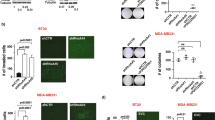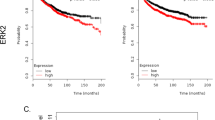Abstract
Breast cancer cells express the chemokine receptor CXCR4 and frequently metastasize to organs with an abundant source of the CXCR4 ligand, stromal cell-derived factor 1 (SDF-1). The chemokine receptor CXCR4 plays an active role in the metastasis of breast cancer. Here, we show that a small interfering RNA (siRNA) against CXCR4 effectively downregulates CXCR4 expression in human MDA-MB-231 breast cancer cells, leading to significant decrease in breast cancer cell invasion and adhesion. It was further found that tumor cells lacking CXCR4 expression proliferated at a much slower rate than control cells in vitro. Surprisingly, tumor cells lacking CXCR4 expression failed to grow in SCID mice in repeated experiments, providing the first direct evidence for an essential role of CXCR4 in breast cancer growth in vivo. This finding suggests an expanded role for the CXCR4 molecule in tumor cell growth in vivo, in addition to its role in breast cancer metastasis. This study implies the CXCR4 molecule as a potential target to control breast tumor growth as well as metastasis.
This is a preview of subscription content, access via your institution
Access options
Subscribe to this journal
Receive 12 print issues and online access
$259.00 per year
only $21.58 per issue
Buy this article
- Purchase on Springer Link
- Instant access to full article PDF
Prices may be subject to local taxes which are calculated during checkout




Similar content being viewed by others
References
Moser B, Loetscher P . Lymphocyte traffic control by chemokines. Nat Immunol. 2001; 2: 123–128.
Gupta SK, Lysko PG, Pillarisetti K, Ohlstein E, Stadel JM . Chemokine receptors in human endothelial cells. Functional expression of CXCR4 and its transcriptional regulation by inflammatory cytokines. J Biol Chem. 1998; 273: 4282–4287.
Nakajima T, Tachibana K, Iizasa H, et al. The lymphocyte chemoattractant SDF-1 is a ligand for LESTR/fusin and blocks HIV-1 entry. Proc Nat Acad Sci USA. 1996; 93: 14726–14729.
Muller A, Homey B, Soto H, et al. Involvement of chemokine receptors in breast cancer metastasis. Nature. 2001; 410: 50–56.
Alenius H, Muller A, Soto H, et al. Involvement of chemokine receptors in breast cancer metastasis. Nat Med. 2002; 8: 157–165.
Bennett I, Cronholm P, Ochroch A, Taichman D, Taichman RS . Use of the stromal cell-derived factor-1/CXCR4 pathway in prostate cancer metastasis to bone. J Urol. 2002; 168: 203–204.
Schrader AJ, Lechner O, Templin M, et al. CXCR4/CXCL12 expression and signalling in kidney cancer. Br J Cancer. 2002; 86: 1250–1256.
Geminder H, Sagi-Assif O, Goldberg L, et al. A possible role for CXCR4 and its ligand, the CXC chemokine stromal cell-derived factor-1, in the development of bone marrow metastases in neuroblastoma. J Immunol. 2001; 167: 4747–4757.
Scotton CJ, Wilson JL, Scott K, et al. Multiple actions of the chemokine CXCL12 on epithelial tumor cells in human ovarian cancer. Combination of quinupristin/dalfopristin and glycopeptide in severe methicillin-resistant staphylococcal infections failing previous glycopeptide regimens. Cancer Res. 2002; 62: 5930–5938.
Murakami T, Maki W, Cardones AR, et al. Expression of CXC chemokine receptor-4 enhances the pulmonary metastatic potential of murine B16 melanoma cells. Cancer Res. 2002; 62: 7328–7334.
Zou YR, Kottmann AH, Kuroda M, Taniuchi I, Littman DR . Function of the chemokine receptor CXCR4 in haematopoiesis and in cerebellar development. Nature. 1998; 393: 524–525.
Tachibana K, Hirota S, Iizasa H, et al. The chemokine receptor CXCR4 is essential for vascularization of the gastrointestinal tract. Nature. 1998; 393: 591–594.
Chen X, Beutler JA, McCloud TG, et al. Tannic acid is an inhibitor of CXCL12 (SDF-1alpha)/CXCR4 with antiangiogenic activity. Clin Cancer Res. 2003; 9: 3115–3123.
Sun YX, Wang J, Shelburne CE, et al. Expression of CXCR4 and CXCL12 (SDF-1) in human prostate cancers (PCa) in vivo. J Cell Biochem. 2003; 89: 462–473.
Brummelkamp TR, Bernards R, Agami R . A system for stable expression of short interfering RNAs in mammalian cells. Science. 2002; 296: 550–553.
Lapteva N, Ide K, Nieda M, et al. Activation and suppression of renin-angiotensin system in human dendritic cells. Biochem Biophys Res Commun. 2002; 296: 194–200.
Wawersik M, Coulombe PA . Forced expression of keratin 16 alters the adhesion, differentiation, and migration of mouse skin keratinocytes. Mol Biol Cell. 2000; 11: 3315–3327.
Strausberg RL, Feingold EA, Grouse LH, et al. Generation and initial analysis of more than 15,000 full-length human and mouse cDNA sequences. Proc Natl Acad Sci USA. 2002; 99: 899–903.
Chen Y, Stamatoyannopoulos G, Song CZ . Down-regulation of CXCR4 by inducible small interfering RNA inhibits breast cancer cell invasion in vitro. Cancer Res. 2003; 63: 4801–4804.
Libura J, Drukala J, Majka M, et al. CXCR4-SDF-1 signaling is active in rhabdomyosarcoma cells and regulates locomotion, chemotaxis, and adhesion. Blood. 2002; 100: 2597–2606.
Staller P, Sulitkova J, Lisztwan J, Moch H, Oakeley EJ, Krek W . Chemokine receptor CXCR4 downregulated by von Hippel–Lindau tumour suppressor pVHL. Nature. 2003; 425: 307–311.
Barbero S, Bonavia R, Bajetto A, et al. Stromal cell-derived factor 1alpha stimulates human glioblastoma cell growth through the activation of both extracellular signal-regulated kinases 1/2 and Akt. Cancer Res. 2003; 63: 1969–1974.
Chen JD, Bai X, Yang AG, Cong Y, Chen SY . Inactivation of HIV-1 chemokine co-receptor CXCR-4 by a novel intrakine strategy. Nat Med. 1997; 3: 1110–1116.
Schroers R, Davis CM, Wagner HJ, Chen SY . Lentiviral transduction of human T-lymphocytes with a RANTES intrakine inhibits human immunodeficiency virus type 1 infection. Gene Therapy. 2002; 9: 889–897.
Zeelenberg IS, Ruuls-Van Stalle L, Roos E . The chemokine receptor CXCR4 is required for outgrowth of colon carcinoma micrometastases. Cancer Res. 2003; 63: 3833–3839.
Acknowledgements
We thank Dr Reuven Agami for providing us with the pSuper vector and Wenhong Ren, Lisa Rollins, Tatiana Goltsova for technical assistance.
Author information
Authors and Affiliations
Corresponding author
Rights and permissions
About this article
Cite this article
Lapteva, N., Yang, AG., Sanders, D. et al. CXCR4 knockdown by small interfering RNA abrogates breast tumor growth in vivo. Cancer Gene Ther 12, 84–89 (2005). https://doi.org/10.1038/sj.cgt.7700770
Received:
Published:
Issue Date:
DOI: https://doi.org/10.1038/sj.cgt.7700770
Keywords
This article is cited by
-
CXCR4 intracellular protein promotes drug resistance and tumorigenic potential by inversely regulating the expression of Death Receptor 5
Cell Death & Disease (2021)
-
siRNA-mediated silencing of CD44 delivered by Jet Pei enhanced Doxorubicin chemo sensitivity and altered miRNA expression in human breast cancer cell line (MDA-MB468)
Molecular Biology Reports (2020)
-
Chemokines in the cancer microenvironment and their relevance in cancer immunotherapy
Nature Reviews Immunology (2017)
-
Cancer-associated fibroblasts promote the progression of endometrial cancer via the SDF-1/CXCR4 axis
Journal of Hematology & Oncology (2016)
-
Identification of chemokine receptors as potential modulators of endocrine resistance in oestrogen receptor–positive breast cancers
Breast Cancer Research (2014)



